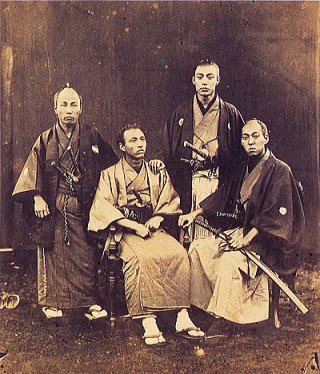THE EDO PERIOD (1603-1868) AND TOKUGAWA IEYASU,
THE FIRST SHOGUN OF THE TOKUGAWAS
when feudal lords fought each other to expand and/or defend their territories
under the loose
control of the Muromachi shogunate which finally fell in 1573.
He was born as the first son of local feudal lord, MATSUDAIRA Hirotada
in Okazaki, east of
Nagoya, central Japan. When he was 19 years old, he became allied with ODA Nobunaga,
other greatest hero who revolved the medieval society in disorder.
Hideyoshi, the third greatest hero who reunited the nation in 1590 and
dead in 1598.
A well-known caricature mentions Nobunaga cooks rice for rice cake, Hideyoshi makes
a rice cake and Ieyasu eats it finally.
by then emperor in 1603 after he won Sekigahara battle against his rival
feudal lords in 1600.
Then he established the TOKUGAWA shogunate government as the third regime
of Samurai
at Edo city (now, Tokyo) which he had started constructing together with Edo castle (now, Imperial
Palace) in Musashi wilds in 1590.
During the Edo period there were 15 shoguns and their administration were
based on physiocracy
depending on rice production. The shogunate proclaimed Military house
code for severe
control over about 300 feudal lords in 1616 after having defeated TOYOTOMI
Hideyori, son of
TOYOTOMI Hideyoshi in Osaka a year before.
One of the important rules of the code was Sankin-Kotai system, i.e. alternative
attendance to
Edo and their fieves. The feudal lords had to travel from their fieves
to EDO and vice versa
every other year with their retainers, left his wife and children as hostage and had some mansions
in EDO, what forced them to spend a lot of fonds.
Although the feudal lords had autonomy in their domains, they were under
severe supervision of
the Shogunate.
or construction works of the facilities of the Shogunate and/or public
works at their accounts
what made them spent so much, too.
As for the international diplomacy, the shogunate closed the country in
1939 expelling Portuguese
and Spanish ships permitting only Holland and China for trade and severely
prohibited
Christianism in Japan. Because Holland had advised the shogunate that Portugal
and Spain had
an intention to invade in Japan with Christianity.
This national isolation policy had lasted more than 200 years until 1858
when the shogunate
opened 4 ports such as Hakodate, Yokohama, Kobe and Nagasaki to foreign countries.
Because American flotilla unexpectedly came to Edo bay (now, Tokyo bay)
in 1853 and 1854,
and pressed a lot the shogunate on the opening of ports with four naval vessels
so that American whale ships could get supply of foods and water. In that
time many American
whalers came around Japan and captured whales to get lamp oil.
In the meantime, thanks to the national seclusion, the shogunate had kept the nation in peace
without warfare and Japan was able to develop a lot her own culture, science,
social system and
so on with high literacy rate of over 50%, the highest in the world.
During the Edo period the shogunate adapted Neo-Confucianism to strengthen
the moral of
Bushi (warrior) class forming Bushido (Japan’s chivalry) and divided people
into for classes
such as those of Bushi, farmer, artisan and merchant.
The shogunate and the feudal lords made all people except those of Bushi
class register
at the temple in their neighborhood adapting five families’group system,
made them watch
each other and inform the authority on any dubious act(s) of other member(s) so as to keep
the feudal society in good shape.
In the first half of the Edo period, the shogunate had maintained the physiocratic system
in good shape. But, with commercial and monetary systems advancing much,
the class of
Bushi was gradually losing its influence and power. On the other hand the
class de merchants
was accumulating fortune and raising their own level of education in the
second part of
18th century.
As a result, the merchants played an important role in the fields of art,
literature, theatrical
drama, entertainments,etc. And the low class of Bushi who had much free
time contributed a lot
to the development of literature, drama and science, too.
Accordingly Ukiyoe (woodblock) print art and theatrical drama (Kabuki)
reached their climax
in those days.
As for education there were thousands of thousand schools called “Terakoya”, where reading,
writing and caluculation were taught to children of famers, artisans and
merchants all over Japan
and the feudal lords had school for the children of Bushi class at their
domains.
Thanks to this education system, the literacy rate of Japanese was always
over 50%. and
above all 4 million of Bushi class who occupied 15% of the total population
was 100%.
In the final stage around 1900 the shogunate faced the discrepancy of the
reality and the theory.
In addition, foreign ships started visiting Japan frequently in order to ask for trade what made
an impact to the many and they thought that a new era might come soon.
Under these circumstancies American flotilla came to Edo bay unexpectedly
in 1853 and 1854,
and threatened the shogunate by four naval vessels to open ports so that American whale
ships could get supply of food and water. The shogunate finally opened four ports such as
Hakodate, Yokohama, Kobe and Kagaseki to foreign countries under unequal pacts in 1858 and
fell in 1868. Then the emperor Meiji realised the restoration of political
power and established
a new centralized government with his followers. Afterwards the emperor transferred the capital to
Edo from Kyoto renaming Edo "Tokyo (eastern Kyoto) " in 1869
in order to realize a rapid
modernization and militarization to protect the nation against foreign
invasion.
And Japan implemented new constitution in 1890 and became one of advanced nations in
three decades.
Note: Many of our habits and customs were established during Edo period.


Portrait of TOKUGAWA Ieyasu